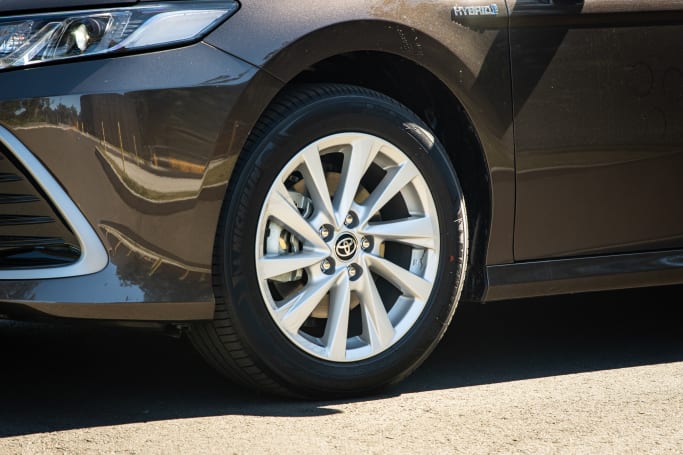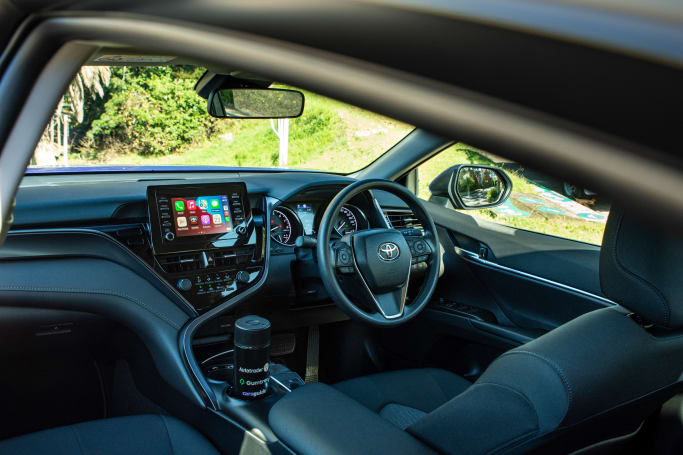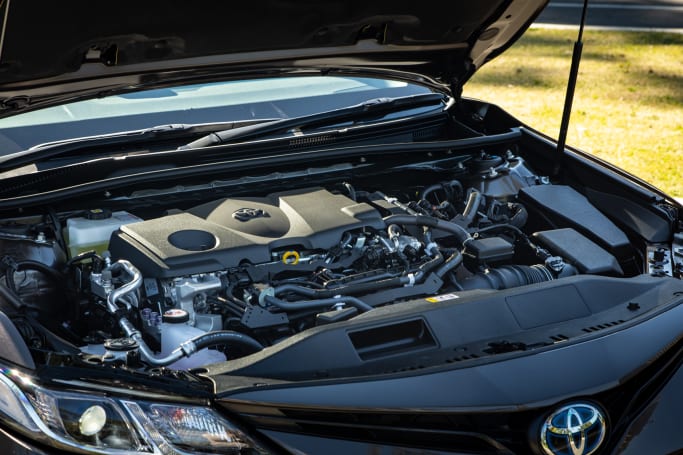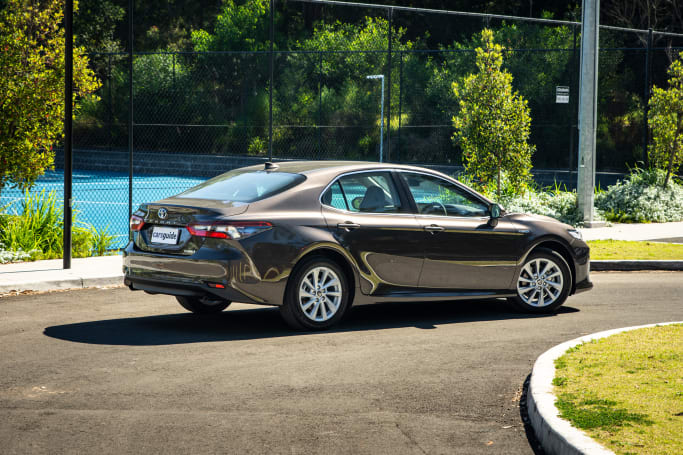
Volkswagen Passat Alltrack 2021 review: 162TSI
Volkswagen doesn't have to bring the now-niche station wagon to Australia, but here are some reasons we're glad it has.
Browse over 9,000 car reviews
Toyota is enjoying a dominant position in the Australian market across many categories.
Here at CarsGuide, we've talked at length about the most trendy ones – the overwhelming demand for the RAV4 and HiLux - but the long-running Camry has chipped away at its mid-size sedan segment to outlive its key rivals and become the master of its domain.
Part of this is keen retail pricing, and a successful transition from Australian manufacturing to Japan-sourced vehicles, but the real key to the Camry's success is the accessibility of its refined hybrid drive.
As such, the brand says more than two-thirds of buyers opt for an electrified Camry, and for this latest 2021 update, the brand has made some major adjustments to its perennial sedan range to reflect this.
So, what's new, and should you really be considering a sedan in 2021? We've taken a look at the facelifted Camry range to find out.

| Toyota Camry 2021: Ascent + SAT NAV Hybrid | |
|---|---|
| Safety rating | |
| Engine Type | 2.5L |
| Fuel Type | Hybrid with Premium Unleaded |
| Fuel Efficiency | 4.5L/100km |
| Seating | 5 seats |
| Price from | $34,540 |
On the face of it, the Camry range looks very similar for 2021, but some of the biggest changes are to this car's grade walk.
The same four variants persist, consisting of the base Ascent, the mid-grade Ascent Sport and sporty SX, and top-spec luxury-focused SL.
Most importantly, Toyota has dumped the 3.5-litre V6 engine option for the range, and made every variant available with its popular 2.5-litre four-cylinder hybrid. There has also been a price adjustment, making every Camry variant marginally more expensive than it was before.

The Ascent kicks off the range wearing a before-on-roads cost (MSRP) of $30,990 for the non-hybrid, or $33,490 for the hybrid. This base car is well equipped, especially compared to some similarly priced SUVs, with standard-spec including 17-inch alloy wheels, a 7.0-inch multimedia touchscreen with Apple CarPlay and Android Auto connectivity, LED headlights, a driver's instrument screen (there is still no digital dash in the Camry range), manual air-conditioning, cloth interior trim, and a wide-angle reversing camera.
The hybrid variant also gains keyless entry and push-start ignition, as well as dual-zone climate control, both of which make the base non-hybrid look quite dated and unappealing. The base Ascent also gets an upgraded safety suite for 2021, which we'll look at later in this review.
Next up is the Ascent Sport. This car adds a visual upgrade over the base car, as well as a larger 9.0-inch multimedia screen with built-in navigation and additional safety items. Now only available as a hybrid, the Ascent Sport wears an MSRP of $36,290, but it's worth noting that if you don't need this car's extra active safety or styling upgrades, the larger screen and sat-nav suite can be had on the base Ascent as a $1000 option (a saving of almost $2000).

The sporty SX is the next grade, offering sportier styling touches, an alternate suspension tune, larger 19-inch alloys, paddle shifters for the transmission, and leather-appointed interior trim. With the discontinuation of the V6, the SX is now hybrid only, wearing an MSRP of $39,190.
Finally, we have the top-spec SL. The SL offers a luxurious alternative to the sporty SX, with smaller 18-inch alloys, heated and cooled front seats, an electric tailgate, auto-dimming rear vision mirror, and a panoramic sunroof. The SL is also only available as a hybrid, wearing an MSRP of $46,990.
Our pick of the range has to be the base Ascent hybrid with the $1000 screen upgrade. It presents outstanding value, with only the best bits of the Camry range. It misses out on a handful of active-safety items, however, which may make it worth your while to spend the extra to upgrade to the Ascent Sport.

This has to be one of the milder facelifts in recent memory. Nothing has changed when it comes to the Camry's profile or overall shape, with only very minor tweaks to each grade's bumper designs. If you're a keen Camry acolyte you may also notice the integrated antenna has been replaced with a roof-mounted fin, and the rear light clusters have been smoked out. Other than that, the standard facelift fare of tweaked garnish and new alloy options is what to expect here.
The overall look is perhaps exactly where it needs to be, though. The Camry is an inoffensive car for corporate fleets and drivers who need a sedan but not one to grab eyes. Indeed, Toyota doesn't need to sell cars with wacky designs like the new Hyundai i30 sedan, nor does it need to be quietly pleasant like the Volkswagen Passat or Skoda Octavia. Instead, it stays the course with the kind of car that anyone could buy without raising eyebrows. At least it's suitably low, giving it a slinky and slightly sporty sedan character, and just saving it from dipping into the realm of being too dorky.
This car's interior is where the biggest changes have taken place. It was one of the earliest cars to bear Toyota's TNGA underpinnings and corresponding new-age interior design. It's sensible and now laid out with a bit more attention paid to ergonomics.
To that end, the multimedia screen, which was once embedded too low in the dash, has now been lifted to a more contemporary, tablet-style design. It swaps positions with the air-vents, aligning it with the designs of the more recently launched Corolla and RAV4 ranges. Elsewhere, the swoopy design continues across the dash with some pleasant shapes and soft-touch materials employed, suiting this car's size and intent.

The seat trim in the non-leather-appointed cars looks pretty ordinary, although I must say it proved comfortable, even on longer trips. The old-school dash layout is endearing, although it would be nice to see some more digitisation here to help the Camry feel a bit more modern from behind the wheel.
Base models also have a bit of a tell when it comes to the abundance of plastic touchpoints, particularly the steering wheel and armrests, this is something that even more basic versions of rivals avoid.
The Camry has a large cabin, giving it inherent practicality over some of its smaller rivals, but it's also worth noting that you shouldn't necessarily rule a sedan out from the get-go as many are just as practical as SUVs, or in the case of the Camry, perhaps even more practical for ferrying adults at the price.
Firstly, look at the front seats. Base Ascent and Ascent sport models offer manual adjust for their pretty ordinary cloth trim, although adjustability is good, as it is in many Toyotas, and once in position it's a very natural feeling place. You're able to sit low in an uncharacteristically sporty position for such a car, and the ergonomics, when it comes to operating the new touchscreen and climate systems, are excellent. Both have handy dials for quick adjustment, and the screen is much better placed for glancing at without taking your eyes off the road.
Storage options include a large centre console armrest box, large dual cupholders, and a sliding tray in front of the shift lever with a deep bay underneath. There are also large bottle holders in the doors, with a small trench for extra objects. My only complaint is that connectivity options are a bit limited. There's only one USB 2.0 port, and one 12v outlet. Many rivals offer more in this department.
The rear seat is almost proof alone that there's still a place for sedans when it comes to ferrying adults. Behind my own (182cm tall) driver's seat position I have almost absurd amounts of knee room, and the width leaves me with the impression that three adults could sit abreast with reasonable comfort levels. The perfect Uber, perhaps? Headroom is a little more limited, thanks to a descending roofline down to the C-pillar, and it's when ducking down into the rear seats that you most notice how low this car really is to the ground.

More arthritic passengers, or those who frequently fit child seats, may find the height of an SUV friendlier here.
Regardless, amenities are decent, with a single large bottle holder in the doors, sturdy pockets on the backs of the seats, and a spongey drop-down armrest with an extra two large bottle holders. The Camry offers dual adjustable air vents for rear passengers, although annoyingly there are no power outlets, which seems like a significant oversight.

Finally, there's the boot. The Camry offers a 524-litre (VDA) space, which is larger than some mid-size SUVs. Indeed, we found the space to be useful, easily consuming our entire CarsGuide luggage set with plenty of space to spare, although I will admit loading and unloading this sedan's boot is not as easy as it is with the large aperture offered by an SUV.
Under the boot floor on hybrid grades there is still room for a space-saver wheel, but the only remaining non-hybrid offers a full-size spare.
As already mentioned, the Camry V6 has been killed off, and honestly it was about time. The dominant drivetrain option, by popular demand so we're told, is the 2.5-litre hybrid.
This drivetrain is a 2.5-litre four-cylinder petrol engine producing 131kW/225Nm, mated to dual electric motors for a total output of 160kW. It drives the front wheels only via a continuously variable automatic transmission.
The base Ascent is the only variant that can be had as a non-hybrid, which now consists of a 2.5-litre four-cylinder petrol engine mated to an eight-speed torque converter automatic to drive the front wheels.

Official fuel consumption is impressive for Toyota's sleek hybrid options, coming in at just 4.7L/100km, figures once unheard of for a car this size. My week of testing over both daily grind and freeway kilometres saw a figure of 5.8L/100km. Not the claimed figure, but again, hard to beat for a vehicle of this magnitude.
Even the remaining non-hybrid option has a bold claim of just 6.8L/100km, although our week of testing that saw a figure predictably closer to 9.0L/100km. The hybrid sells itself, really, as you'll be able to beat the non-hybrid on fuel consumption, even without sparing a thought to making the most of it. It really is a click-and-forget fuel-saving solution.
Both Camry drivetrain options are technically capable of consuming base-grade 91RON unleaded fuel, although Toyota recommends mid-shelf 95. The non-hybrid has a fuel-tank capacity of 60L, while hybrids have slightly smaller 50L capacities.
This Camry update will carry across the car's maximum five-star ANCAP rating from 2017, although there are some welcome updates to its active suite this time around.
Base cars score auto emergency braking, which works to freeway speeds with pedestrian and cyclist detection during the daytime, adaptive cruise control, traffic-sign recognition, and auto high beams.
New for 2021 on base cars are lane-keep assist with lane-departure warning, as well as an emergency SOS and stolen-vehicle-tracking system, which can summon emergency services with the press of a button, or automatically if the airbags are deployed.
The mid-grade Ascent Sport and SX trim levels add blind-spot monitoring and rear cross traffic alert, while the top-spec SL adds a surround camera suite and head-up display.
It's a competitive active suite on any grade, although it does little to move the envelope forward. All Camrys also have seven airbags (the standard dual front, side, and curtain, plus a driver's knee) and the expected stability, traction, and brake controls.
Basic Warranty
5 years / unlimited km warranty
ANCAP Safety Rating

All Camry variants are covered by Toyota's competitive five-year and unlimited-kilometre warranty promise, which matches segment rivals like Volkswagen and Honda. Toyota will extend warranty on the drivetrain for up to seven years if the service books are kept with a Toyota dealer, and the brand covers the hybrid battery for up to 10 years.
The Camry is also covered by a very impressive capped-price-servicing program, which sees the first four services (required at 12 monthly or 15,000km intervals) cost just $220. Be wary, costs increase beyond this point, although they will still be more affordable than many rivals.

I know the Camry has had a history of being pretty ordinary to drive, but since the launch of this new TNGA-based car in 2017, things have taken a leap in terms of how nice the experience is behind the wheel.
This car's low ride height and notable width really come into play, making it feel secure and grippy on the road. The steering is perhaps not as full of feel as it could be, with dollops of electrical assistance, but it's impressive how light it is at low speeds, making it easy to park such a large car.
This lightness also suits the hybrid's character more than anything. Outside of the ultra-low-drag Prius, the 2.5-litre four-cylinder version of the signature Toyota system is the best one on the market. The electric motors are notably scaled up from the smaller Corolla or Prius, giving an excellent range of motion under electric power alone.
The system allows the Camry to take off in smooth silence from the get-go, removing any transmission woes from the equation, and leaving you with the impression of a seamless, almost luxurious drive experience. In stop-start travel, or at low commuting speeds, it's even a little hard to tell when the 2.5-litre engine kicks on, because at low revs it's surprisingly quiet.

While it might not be the most engaging car to accelerate hard in, the combination of a decently sized engine and the torque boost from the electric motor certainly get things going, leaving enough power for overtaking manoeuvres at higher speeds. It's notably more refined in these scenarios than the thrashy Corolla, for example.
The ride is also nicely tuned to ram home how smooth and comfortable Toyota intends its hybrids to be. The base-spec hybrid with small alloys, healthy tyre profiles, and the compliant ride make for a car that dispatches potholes and road imperfections with relative ease. It should be noted that we did not sample the SX and its sportier ride for this review, so stay tuned for a variant review in the future with regard to this car's specific ride quality.
Seat comfort and visibility out of the Camry are also notable, regardless of grade, for long periods of time, solidifying this car's position as an excellent choice for an efficient tourer. It is a little hard to see out the rear, though, with the boot lid being notably high from the low seating position, and how low the Camry is could potentially be an issue for some buyers. It's low enough that it's susceptible to scraping on tall driveways and even some suburban speed bumps.
We also sampled a base-spec non-hybrid for this range test, and perhaps the most notable thing about it is how unsophisticated it feels compared to its hybrid counterparts. The drop in refinement is obvious, and while we appreciate the inclusion of a torque converter transmission over a CVT, the acceleration experience just felt tired and dated compared to how sleek and effortless the hybrid proved to be.
The Camry continues to be a quiet achiever for Toyota, dominating the mid-size-sedan bracket, and with its sensible pricing, appealing range of variants, and stellar hybrid-drive, it's easy to see why nothing comes close.
If nothing else, this latest update proves that this perennial sedan has well and truly outlived its need for a non-hybrid version.
Our pick of the range is the base Ascent hybrid as it's the most no-nonsense option, offering the best Camry attributes at the most impressive price-point. It's worth spending the extra $1000 on the upgraded multimedia suite, as it will still be better value than the Ascent Sport regardless.
| Vehicle | Specs | Price* | |
|---|---|---|---|
| Ascent Sport | 2.5L, ULP, 6 SP AUTO | $30,140 – 36,300 | 2021 Toyota Camry 2021 Ascent Sport Pricing and Specs |
| Ascent | 2.5L, ULP, 6 SP AUTO | $27,940 – 33,660 | 2021 Toyota Camry 2021 Ascent Pricing and Specs |
| Ascent Hybrid | 2.5L, Hyb/PULP, CVT AUTO | $33,660 – 40,040 | 2021 Toyota Camry 2021 Ascent Hybrid Pricing and Specs |
| SL | 3.5L, ULP, 8 SP AUTO | $40,150 – 47,190 | 2021 Toyota Camry 2021 SL Pricing and Specs |
| Price and features | 8 |
|---|---|
| Design | 7 |
| Practicality | 7 |
| Under the bonnet | 7 |
| Efficiency | 9 |
| Safety | 8 |
| Ownership | 8 |
| Driving | 8 |
$26,484
Lowest price, based on 482 car listings in the last 6 months